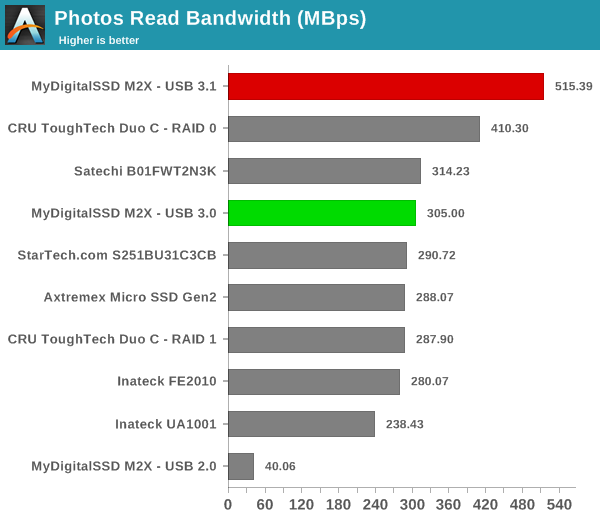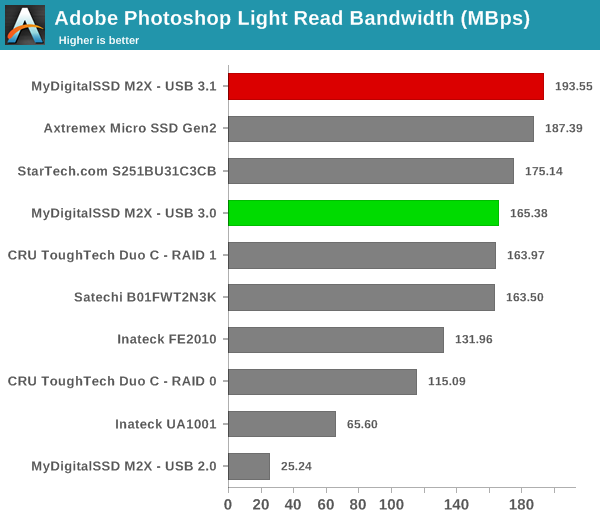MyDigitalSSD M2X M.2 NVMe SSD Enclosure Review - A PCIe to USB Storage Bridge
by Ganesh T S on October 31, 2018 8:00 AM EST- Posted in
- Storage
- SSDs
- USB 3.1
- NVMe
- Type-C
- Storage Bridge
- External SSDs
Performance Benchmarks
Our evaluation routine for storage bridges borrows heavily from the testing methodology for direct-attached storage devices. The testbed hardware is reused. CrystalDiskMark is used for a quick overview, as it helps determine availability of UASP support and provides some performance numbers under ideal scenarios. Real-world performance testing is done with our custom test suite involving robocopy bencharks and PCMark 8's storage bench.
CrystalDiskMark uses four different access traces for reads and writes over a configurable region size. Two of the traces are sequential accesses, while two are 4K rando accesses. Internally, CrystalDiskMark uses the Microsoft DiskSpd storage testing tool. The 'Seq Q32T1' sequential traces use 128K block size with a queue depth of 32 from a single thread, while the '4K Q32T1' ones do random 4K accesses with the same queue and thread configurations. The plain 'Seq' traces use a 1MiB block size. The plain '4K' ones are similar to the '4K Q32T1' except that only a single queue and single thread are used.
Comparing the '4K Q32T1' and '4K' numbers can quickly tell us whether the storage device supports NCQ (native command queuing) / UASP (USB-attached SCSI protocol). If the numbers for the two access traces are in the same ballpark, NCQ / UASP is not supported. This assumes that the host port / drivers on the PC support UASP. We can see that the M2X enclosure has no trouble with UASP support.
| Storage Bridge Benchmarks - CrystalDiskMark | ||
 |
 |
|
Moving on to the real-world benchmarks, we first look at the results from our custom robocopy test. In this test, we transfer three folders with the following characteristics.
- Photos: 15.6 GB collection of 4320 photos (RAW as well as JPEGs) in 61 sub-folders
- Videos: 16.1 GB collection of 244 videos (MP4 as well as MOVs) in 6 sub-folders
- BR: 10.7 GB Blu-ray folder structure of the IDT Benchmark Blu-ray (the same that we use in our robocopy tests for NAS systems)
The test starts off with the Photos folder in a RAM drive in the testbed. robocopy is used with default arguments to mirror it onto the storage drive under test. The content on the RAM drive is then deleted. robocopy is again used to transfer the content, but, from the storage drive under test to the RAM drive. The first segment gives the write speed, while the second one gives the read speed for the storage device. The segments end with the purge of the contents from the storage device. This process is repeated thrice and the average of all the runs is recorded as the performance number. The same procedure is adopted for the Videos and the BR folders. Readers interested in looking at all the graphs in one shot can choose the 'Expand All' option in the dropdown menu.

High-performance external storage devices can also be used for editing multimedia files directly off the unit. They can also be used as OS-to-go boot drives. Evaluation of this aspect is done using PCMark 8's storage bench. The storage workload involves games as well as multimedia editing applications. The command line version allows us to cherry-pick storage traces to run on a target drive. We chose the following traces.
- Adobe Photoshop (Light)
- Adobe Photoshop (Heavy)
- Adobe After Effects
- Adobe Illustrator
Usually, PC Mark 8 reports time to complete the trace, but the detailed log report has the read and write bandwidth figures which we present in our performance tables. Note that the bandwidth number reported in the results don't involve idle time compression. Results might appear low, but that is part of the workload characteristic. Note that the same CPU is being used for all configurations. Therefore, comparing the numbers for each trace should be possible across different DAS units. Readers interested in looking at all the graphs in one shot can choose the 'Expand All' option in the dropdown menu.

As expected, the M2X simply outperforms every other USB storage bridge that we have tested so far (note that we don't have any Thunderbolt 3 external SSDs in the graphs). The move to USB 3.1 Gen 2 in various enclosures has now finally met its match in the form of a downstream M.2 NVMe port. While USB 3.0 couldn't effectively saturate SATA SSDs, USB 3.1 Gen 2 could. In fact, it left a lot of performance on the table since the bottleneck was shifted to the SSD side. With the M2X enclosure, we see that the bottleneck is now back to the USB side.










39 Comments
View All Comments
RoC_17 - Wednesday, October 31, 2018 - link
Thanks for this review, a niche category which I had my eyes upon for a while.Still, I would prefer to have an alternative mounting mechanism for the SSD inside the enclosure for better thermal handling.
Sliding in means that attaching thermal pads is not possible, but thermals surely would benefit from that. Why not have a top cover with 4 low profile screws for exactly that reason?
woggs - Wednesday, October 31, 2018 - link
Bingo. I bought one but really need to ensure a solid thermal connection from the controller on the drive to the case or it will overheat. I ended up not using the case that came with it and bought a separate M.2 heatsink kit with proper thermal adhesive to make solid contact to the asic on the drive. Now it works great.woggs - Wednesday, October 31, 2018 - link
To be clear, I tried the original case and the drive hung (thermal shut down) during sustained writes....Clarkage - Wednesday, October 31, 2018 - link
The instructions show a thermal pad that's to be installed on top of the drive before sliding it in. Did your case have this / did you use it ? I'm certainly not convinced that's it's sufficient heat sinking but was curious about your particular situation.Also, what drive was it? [just curious]
woggs - Wednesday, October 31, 2018 - link
Well crap. I did not get one (or I've forgotten already).weevilone - Thursday, November 1, 2018 - link
Mine came with the thermal interface, but it was so sticky that I couldn't slide the enclosure over the drive with the material in place.weevilone - Thursday, November 1, 2018 - link
Can you share what you wound up using? I sent mine back after failing to get the included thermal interface to work with the sliding case.jabber - Wednesday, October 31, 2018 - link
I need to get one of this type of adapter for testing and build cloning. Currently having to use a PCI-e card and it's a pain.Mikewind Dale - Wednesday, October 31, 2018 - link
What excites me is that now I can easily clone my laptop's NVMe SSD to a new one before upgrading the SSD, without having to do a bunch of workarounds (like finding a desktop with multiple M.2, or cloning to SATA as a middleman).SonnyCrockett84 - Thursday, November 1, 2018 - link
Which is exactly what I did with my Dell XPS 15 9575 2in1, went from a 256 to a 512. I bought mine from Aliexpress on September 13th, though, 32 bucks, from JEYI, took a couple of weeks to get here, no biggie. Here's the link https://www.aliexpress.com/item/-/32874418125.html